In the first half of 2020, Mara Elephant Project reported the highest level of illegal logging seizures since our inception. Well, in the second half of 2020, our rangers saw even higher levels of illegal logging, charcoal production and bushmeat poaching. Rangers are the first line of defense on the ground to combat habitat loss and poaching, which is why in key areas of the Mara, an increased presence on the ground in response to this alarming rise is key. MEP held a recruitment for local men and women in the Loita area in September and we are pleased to announce this team completed their 6-week training on MEP’s campus and were deployed in December. These 10 new rangers were honored at a passing out parade (graduation) in November in the Entesekera trading center on the edge of the Loita Forest to celebrate the launch of the additional MEP rangers into this area. The parade was not only important to showcase the change the recruits have undergone but also formally present themselves to the community as guardians of the area. MEP works alongside communities and government to increase protection for the Mara’s wildlife, communities and habitat, which makes sharing these successes with them all that more meaningful. The new rangers are proud to be protecting Kenya’s national heritage and their backyards. They are fully kitted with all the gear they need to operate in this area, and they have already made a dent in the logging cartels working in the area and the community and local administration have been supportive of our newly increased efforts to stop the forest destruction and employ their youth. We are excited to see what impact they’ll make in 2021.

At the new MEP ranger passing out ceremony in Loita.
The other remarkable news from 2020 that MEP is very proud of is that we retained our full complement of rangers through these difficult times, which has led to a record number of arrests and recoveries. Keeping the rangers deployed has been extremely important this year as we have seen an increase in bushmeat poaching and habitat destruction. We have been frustrating logging operations and arresting bushmeat poachers.
The bushmeat poaching in the Mau Forest has increased at an alarming rate. Our partners at the Bongo Surveillance Project (BSP) also reported very high levels of bushmeat poaching using snares surrounding the bongo hot spots which is extremely worrying as there are probably less than 20 bongo antelopes left in the forest. BSP CEO Mike Prettejohn reported that in July their trap cameras only took one fleeting photo of a bongo the whole month. MEP’s Sheldrick Wildlife Trust (SWT) Mau De-Snaring Units have teamed up with BSP and Kenya Forest Service (KFS) to fight the snaring which plagues this area. We have also continued our efforts in the Loita Forest and the Nyakweri Forest to increase protection for the wildlife, communities and habitat.
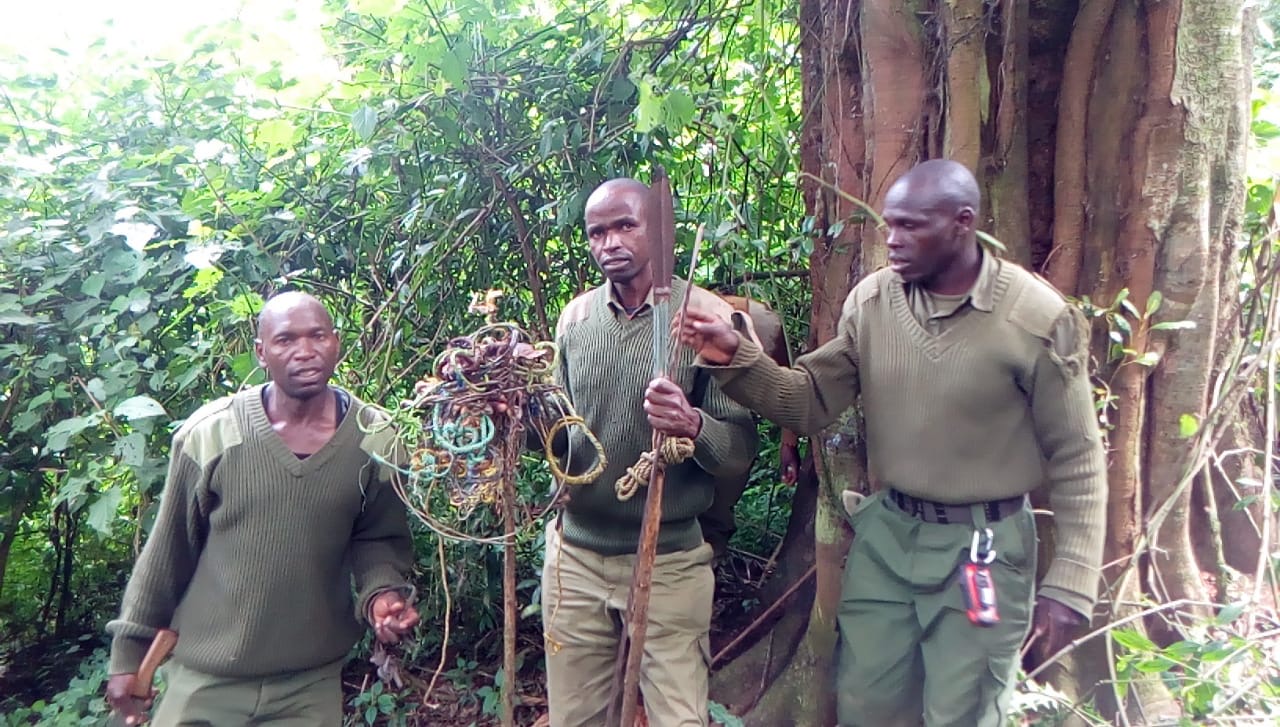
The SWT Mau De-Snaring Unit with snares and spears collected in the forest in July.
To this point, in July, I was asked to take a team of journalists from K24 around the Nyakweri Forest to illustrate the level of deforestation. This piece came out one week later and can be found here. This forest is home to over 50 elephants including Kenya Wildlife Service (KWS) and MEP collared elephant Fitz, sponsored by the Angama Foundation. His movements are illustrating how the elephants are using the forest. During the day they don’t really move and as soon as night falls, they go crop raiding in the surrounding farms which continue to encroach into the forest. In August, we hosted world famous wildlife photographer and conservationist David Chancellor for several weeks and during his time at MEP, he spent time embedded with the MEP Alpha ranger unit stationed in the Nyakweri Forest. He was with them as they were responding to conflict day and night.
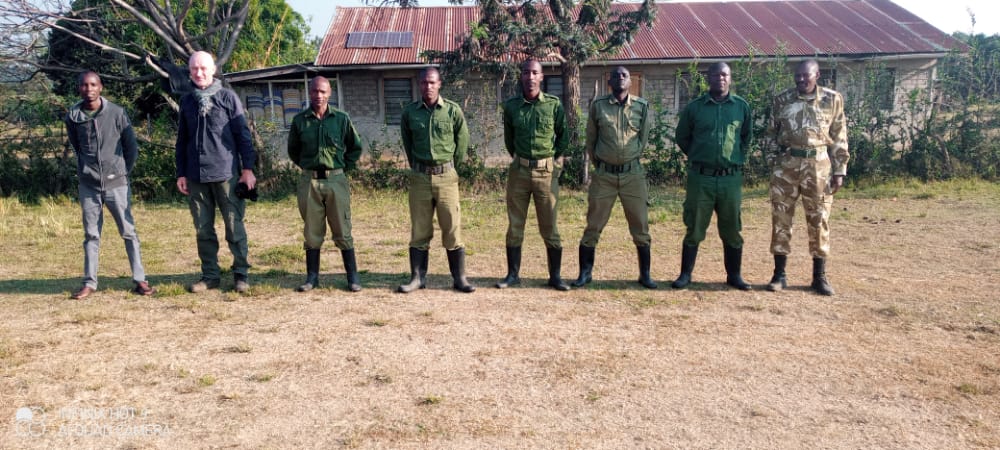
David Chancellor during a morning roll call photo with his designated MEP ranger unit.
David also got to join the KWS and MEP collaring operation of a bull elephant in Oderekesi Conservancy as part of identifying the southern Sand River corridor from the Maasai Mara National Reserve (MMNR) to the Loita Forest. KWS and MEP also collared an additional female elephant, Harriet, in this area in September. The river flows through unprotected land that is often the center of conflict between wildlife and communities. MEP along with partners KWS and Olderekesi Conservancy are eager to learn more about conflict in this area and how elephants are using a corridor that connects Loita to the Reserve. The Sand River is an important source of surface water for elephants and all wildlife and provides a critical corridor for them to move into the Loita Forest during times of drought. The river is also key for the surrounding communities who use it as a source of water and who farm tomatoes along its banks, which leads to conflict as the people and wildlife are competing for the same resource. Newly collared elephants in this area will help us to both define the corridor and provide an early warning to conflict.

Bull elephant David being collared on August 17.
The Karen Blixen Camp Trust helicopter flew an extraordinary number of hours in the second half of 2020 due to the demand for increased reconnaissance, collaring operations, increased conflict and an EMS flight. In total, the helicopter flew 91.5 hours in the third quarter alone with missions including aerial patrol in the Mau Forest, collared elephant monitoring in places as far away as Baringo, conflict incidents and government partner support.
In September, a small team of scouts managed by Kerry Outram patrol the Marmanet Forest in Baringo County, where collared elephant Vasco, supported by the Indianapolis Zoo, resides with his herd. One of the scouts reported an injured elephant in Vasco’s herd so MEP deployed the helicopter on September 20 and brought along SWT and KWS Vet Dr. Limo in hopes of locating the injured elephant and treating him. Using the real-time tracked location of Vasco, we located the herd but were unable to spot the injured elephant. We did note that Vasco was in good health. MEP’s response to conflict in the helicopter received some national media attention when a large male elephant got stuck in a tea plantation in Kericho causing large crowds of local community members to gather. While elephants are not drawn to tea plants as a source of food, it can happen that one strays from the Mau Forest into these tea plantations and then their path is blocked back into the forest. KWS and MEP rangers were on the ground handling the situation; however, the helicopter was needed to quickly push the stubborn bull back to the forests edge. The story was featured nationally in Kenya in The Standard and The Star.
 This in addition to an EMS flight that took place on October 1. MEP received an urgent call from Jeffrey Wu that a young boy was charged by a cape buffalo and had serious injuries that needed immediate attention. I quickly flew to pick up the boy and safely transported him to Tenwek Hospital (pictured left) where he received treatment for a puncture wound in his bottom and right side of his stomach. Luckily, he is expected to recover and was very brave during our flight. On October 17, I was involved in a helicopter crash in the Mau region of the Maasai Mara, Kenya. There were no injuries but the Robinson R44 helicopter owned by Karen Blixen Camp Trust was severely damaged and is out of operation indefinitely.
This in addition to an EMS flight that took place on October 1. MEP received an urgent call from Jeffrey Wu that a young boy was charged by a cape buffalo and had serious injuries that needed immediate attention. I quickly flew to pick up the boy and safely transported him to Tenwek Hospital (pictured left) where he received treatment for a puncture wound in his bottom and right side of his stomach. Luckily, he is expected to recover and was very brave during our flight. On October 17, I was involved in a helicopter crash in the Mau region of the Maasai Mara, Kenya. There were no injuries but the Robinson R44 helicopter owned by Karen Blixen Camp Trust was severely damaged and is out of operation indefinitely.
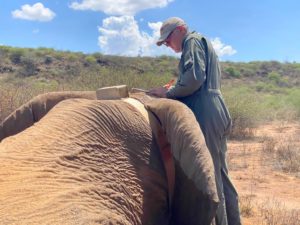 We continued with aerial operations after October and hired an R44 helicopter operated by Helicopter Charters East Africa on an hourly charge. We used this helicopter to re-collar Hannibal (pictured right) alongside KWS and to respond to conflict. We conducted several conflict flights in the Suswa region where a large herd of over 70 elephants were destroying community dams and disturbing herders near Suswa Mountain. Collared elephants Hannibal and Napoleon are in this herd, and though difficult to manage, the community and KWS were very appreciative of the support.
We continued with aerial operations after October and hired an R44 helicopter operated by Helicopter Charters East Africa on an hourly charge. We used this helicopter to re-collar Hannibal (pictured right) alongside KWS and to respond to conflict. We conducted several conflict flights in the Suswa region where a large herd of over 70 elephants were destroying community dams and disturbing herders near Suswa Mountain. Collared elephants Hannibal and Napoleon are in this herd, and though difficult to manage, the community and KWS were very appreciative of the support.
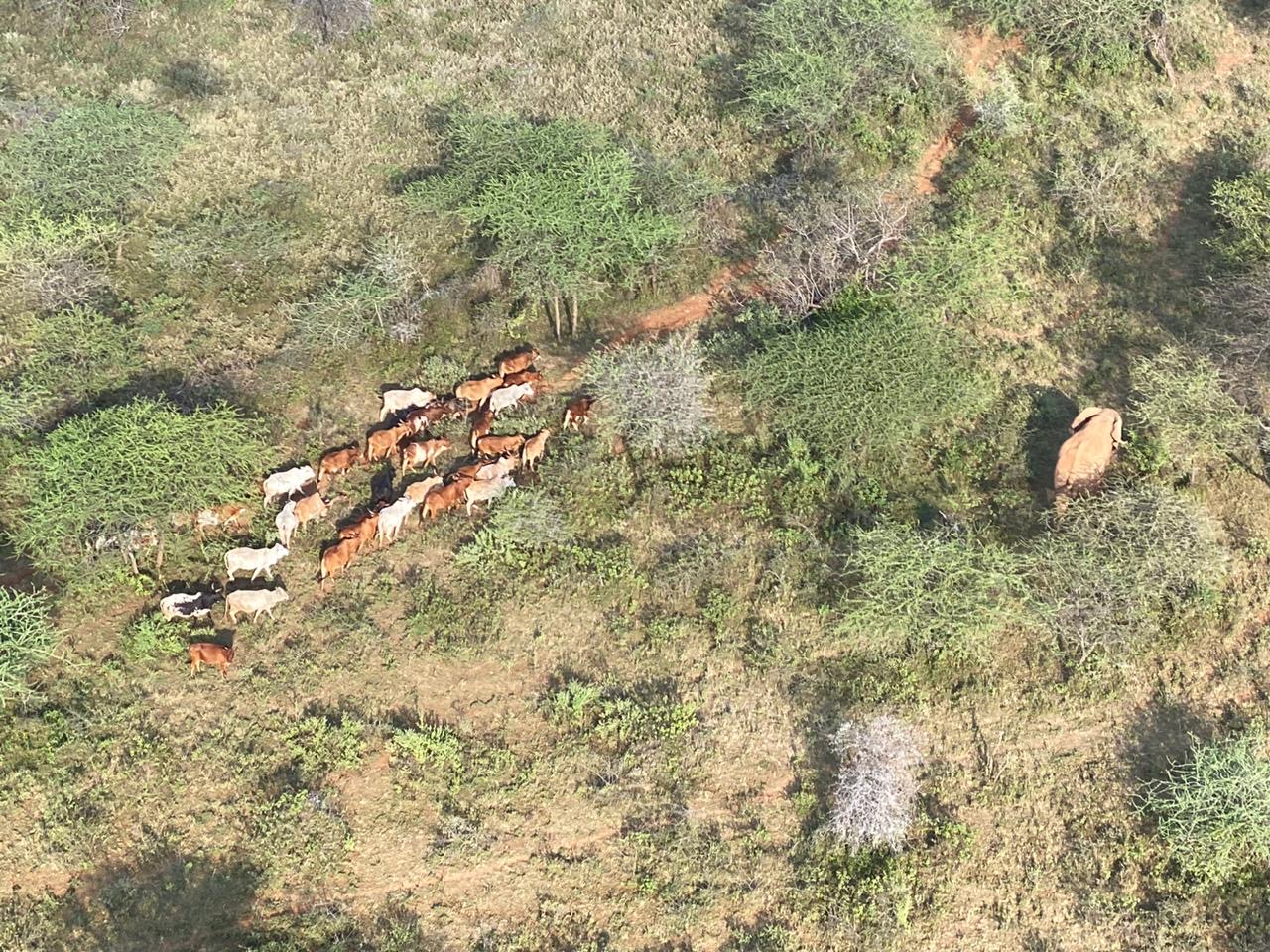
Collared elephant Hannibal photographed from the helicopter.
Dr. Jake Wall and I attended the Central Rift Valley Conservation Area National Elephant Action Plan meeting in Naivasha with KWS. It was a good chance to catch up on collaring plans and share updates from the whole Rift Valley. MEP was requested by KWS to analyze the effectiveness of HEC methods deployed by MEP and of specific interest was the use of drones to mitigate HEC. MEP has been working with a consultant to help register our drones and get flight permissions to use them to mitigate HEC and we recently received registration documents for the four drones we have and authorization to operate them for 1 year. This has been a long time coming and I am very excited to get back into the air autonomously.
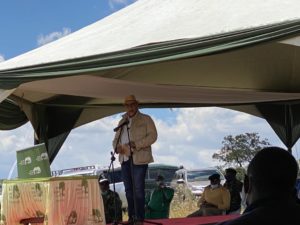 In early August, Honorable Najib Balala, Kenya’s Cabinet Secretary for Tourism and Wildlife, visited the Maasai Mara (pictured left) and MEP was honored to spend some time with him while launching the national Lion Strategy Plan, visit MEP and tour the Mara together. On this trip I also met marathon world record holder Eliud Kipchonge who was visiting the Mara for the first time with Hon. Balala. On October 31, I attended a joint celebration of the one-year anniversary of the Maasai Mau Forest reclamation. Attended by high level government officials and local agencies committed to protecting the Mau Forest Complex, a tree planting ceremony took place at the Senetwet Primary School in Maasai Mau Forest. The ecological, social, and economic significance of Maasai Mau Forest (MMF) Block to Kenya, Eastern African region, Africa and the World, cannot be overemphasized. The continuous widespread encroachments and destruction of the forest block presents environmental, economic and security threats. These threats are being addressed by the government with a land reclamation process, which MEP supports.
In early August, Honorable Najib Balala, Kenya’s Cabinet Secretary for Tourism and Wildlife, visited the Maasai Mara (pictured left) and MEP was honored to spend some time with him while launching the national Lion Strategy Plan, visit MEP and tour the Mara together. On this trip I also met marathon world record holder Eliud Kipchonge who was visiting the Mara for the first time with Hon. Balala. On October 31, I attended a joint celebration of the one-year anniversary of the Maasai Mau Forest reclamation. Attended by high level government officials and local agencies committed to protecting the Mau Forest Complex, a tree planting ceremony took place at the Senetwet Primary School in Maasai Mau Forest. The ecological, social, and economic significance of Maasai Mau Forest (MMF) Block to Kenya, Eastern African region, Africa and the World, cannot be overemphasized. The continuous widespread encroachments and destruction of the forest block presents environmental, economic and security threats. These threats are being addressed by the government with a land reclamation process, which MEP supports.
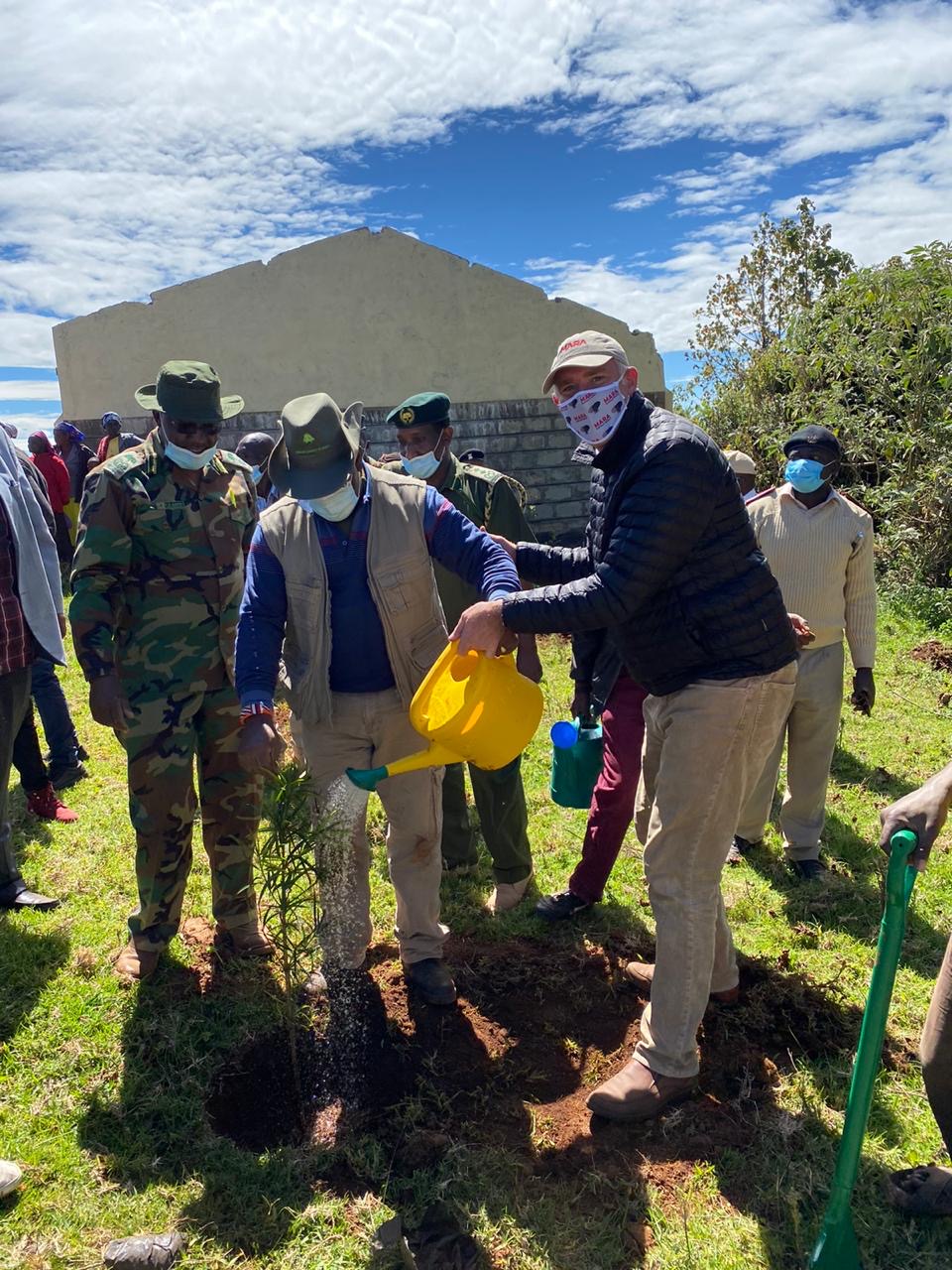
Planting a tree alongside MEP partners.
2020 has been a challenging year globally and as we wind the year to a close it is always good to reflect on positive stories and Mara Elephant Project has a big one to share. This year MEP raised a record amount of funding, and in December it was our largest fundraising month in the history of the organization, all THANKS TO YOUR SUPPORT. We are humbled by the overwhelming support donors like you have given our organization in a very trying year.


